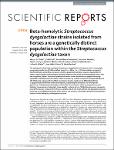Beta-hemolytic Streptococcus dysgalactiae strains isolated from horses are a genetically distinct population within the Streptococcus dysgalactiae taxon
Pinho, Marcos D.
Erol, Erdal
Ribeiro-Gonçalves, Bruno
Mendes, Catarina I.
Carriço, João A.
Matos, Sandra C.
Preziuso, Silvia
Luebke-Becker, Antina
Wieler, Lothar H.
Melo-Cristino, Jose
Ramirez, Mario
The pathogenic role of beta-hemolytic Streptococcus dysgalactiae in the equine host is increasingly recognized. A collection of 108 Lancefield group C (n = 96) or L (n = 12) horse isolates recovered in the United States and in three European countries presented multilocus sequence typing (MLST) alleles, sequence types and emm types (only 56% of the isolates could be emm typed) that were, with few exceptions, distinct from those previously found in human Streptococcus dysgalactiae subsp. equisimilis. Characterization of a subset of horse isolates by multilocus sequence analysis (MLSA) and 16S rRNA gene sequence showed that most equine isolates could also be differentiated from S. dysgalactiae strains from other animal species, supporting the existence of a horse specific genomovar. Draft genome information confirms the distinctiveness of the horse genomovar and indicates the presence of potentially horse-specific virulence factors. While this genomovar represents most of the isolates recovered from horses, a smaller MLST and MLSA defined sub-population seems to be able to cause infections in horses, other animals and humans, indicating that transmission between hosts of strains belonging to this group may occur.
Dateien zu dieser Publikation
Keine Lizenzangabe

